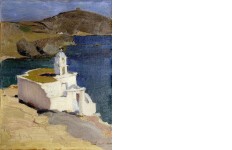Oil painting 151Drawing 125Mixed media 21Watercolor painting 4Tempera 4Gouache 2Οil pastel 1Pastel 2Engraving 1
Special Information for the Artist
TITLESAINT MARKOS OF TINOS
MEASUREMENTS (cm)Height : 56
Width : 44
USED MATERIALSOil painting (Oil on canvas)
SIGNATURELower Left
CHRONOLOGY01-01-1923 - 01-01-1923
AUTHENTICITY CHECKNot checked

Painted in 1923.
signed in Greek (lower left); bearing title and date (on the reverse)
PROVENANCE:
Private collection, Athens.
EXHIBITED:
Athens, Zappeion, Retrospective exhibition, 1929, no 67 or 78;
Athens, Nees Morfes Gallery, 'Once upon a time there was art',
December 1995 (illustrated in the exhibition catalogue, p.5);
Athens, National Gallery and Alexander Soutzos Museum, Nikos Lytras
Retrospective, 19 March-2 June 2008.
LITERATURE:
I.M.R, Pyrsos Encyclopaedia, Athens 1926, vol. 16, p. 378, referred
(possibly).
Newspaper clipping signed Til', Nikolaos Lytras file, Athens National
Library Archive, referred (possibly).
Afroditi Kouria, Dimitris Portolos, 'Nikos Lytras', National Gallery and
ELIA edition, Athens 2008, p. 151, no 105 (illustrated).
Chariklia-Glafki Gotsi, The artist Nikos Lytras, dissertation thesis,
Thessaloniki 1992, pp 54-55, 90, illustration no 46.
Eugenios Matthiopoulos, 'Participation of Greece at the Venice Biennale
1934-1940', dissertation thesis, University of Crete 1996, p. 620,
plate 71.
"Take a look at the painting showing a lone white chapel on the island of Tinos. Notice the depth of colour in the background. Lytras's works radiate light with amazing colours and powerful juxtapositions." [Clipping of newspaper art review, Nikolaos Lytras File, Athens National gallery Archive.] In the same vein, reviewing Lytras's major posthumous retrospective in 1929, writer and critic Zacharias Papantoniou noted: "I believe that the dark tone Lytras came up with and used as a backdrop for the dazzling whiteness of St. Markos church is unique among all orientalists," 1 while author, poet and critic I.M. Panayotopoulos ranked St. Markos church, Tinos among the painter's best works.2
In the summer of 1923, just before or just after he was appointed professor at the Athens School of Fine Arts, Lytras visited Tinos, the native island of his father, the great 19th century painter Nikiforos Lytras. The island's intricate shoreline became a source of inspiration for the artist, who produced a number of exquisite landscapes. "His fatherland, with its sparse, jugged terrain and sculptural quality of both its natural environment and traditional Cycladic architecture, all sustaining a dynamic balance under an ongoing discourse, offered Lytras many pictorial challenges inspired by the stark juxtapositions that engender powerful visual impressions. It should be noted that in all of his Tinos paintings, Lytras consistently avoids general or panoramic views of the island's village complexes. Usually, only some scattered houses, identified by their solid, cubelike volumes, are juxtaposed with the wavy lines and flowing rhythms of the natural environment. His search for such powerfully expressive juxtapositions possibly gave birth to his two pictures of the St. Markos church, both included in the painter's 1929 retrospective." 3
The other painting with the same title shows a lot of similarities with lot 23, including the same more-or-less vantage point and overall handling of form, but the compositional scheme is radically different, with the rolling background hills severely cropped to fit an horizontal format. The Bonhams picture shares the same sense of radiating light reflected on the church's whitewashed walls against a cobalt blue sea, but its vertical format lets the landscape breathe, allowing the painter to comfortably explore depth. Note how the belfry's vertical form engages in a dialogue with the tiny white church perched on the rock across the bay and the dark windmill crowing the hill at the distance, creating a rhythmical sequence and directing the eye from main subject to middleground to background. This skilful spatial organization complemented by certain master touches, such as the wonderful red outline of the belfry's dark shadow cast on the flat roof, allow us to suggest that the favourable reviews St. Markos church, Tinos received back in the 1920s referred to the painting now offered at auction.
Like a freshly painted caique ready to sail the cobalt blue sea, the dazzling Cycladic church captures the power, brilliance and mythical allure of the archipelago, while demonstrating Lytras's interpretative approach to nature. As noted by art critic O. Daniilopoulou, "beyond the little chapel perched on the rocky edge, Lytras captures the powerful character of the sea."4 Energetic brushwork, vibrant form and textured surface support the liberation of properties intrinsic to his medium, asserting the freedom of his pictorial gesture. Comparing St. Markos church, Tinos to landscapes from his earlier output, one can observe an increasing propensity towards abstractive rendering, a tendency to break away from the world of appearances and create a new reality through an architectural organization of space and handling of form, without abandoning naturalistic colouring. 5
In his search for an interpretative approach to nature and a deeper pictorial truth, Lytras infused the forces of renewal in Greek painting with a fresh and vital impetus and had a major impact on the 1930s generation. As noted by Athens National Gallery Director M. Lambraki-Plaka, "Nikolaos Lytras was a painter committed to the truth of vision, perhaps the most representative exponent of early Greek plein-air painting. He was a true revolutionary who reinvigorated Greek painting and left a rich legacy of works full of vitality and inner truth that can deservedly stand next to the great masterpieces of early European modernism." 6
1 Eleftheron Vima daily, 18.4.1929.
2 I.M.P(anayotopoulos), Pyrsos Encyclopaedia [in Greek], Athens 1926, vol. 16, p. 378.
3 A. Kouria, D. Portolos, Nikos Lytras, Building Form with Colour and Light [in Greek], National Gallery-A. Soutzos Museum & Hellenic Literary and Historical Archive, Athens 2008, pp. 115-117.
4 O. Daniilopoulou, Once Upon the Time there was Painting [in Greek], exhibition catalogue, Nees Morfes Gallery, Athens 1995, p. 5.
5 See H.G. Gotsi, The Painter Nikos Lytras 1883-1927 (graduate thesis) [in Greek], Thessaloniki, 1992, pp. 53-54.
6 M. Lambraki-Plaka, introduction to Nikos Lytras, Building Form with Colour and Light, p. 14.